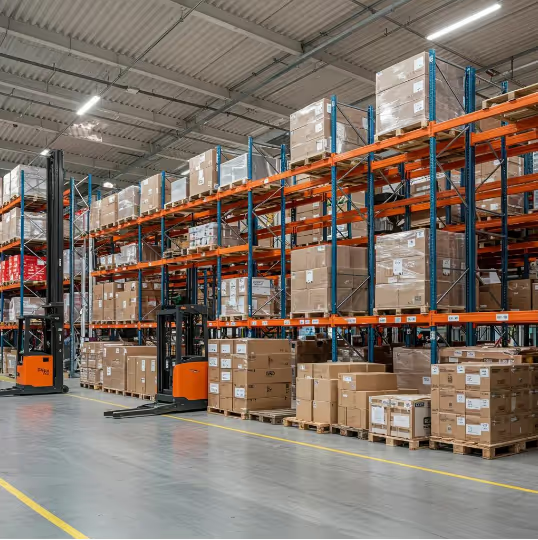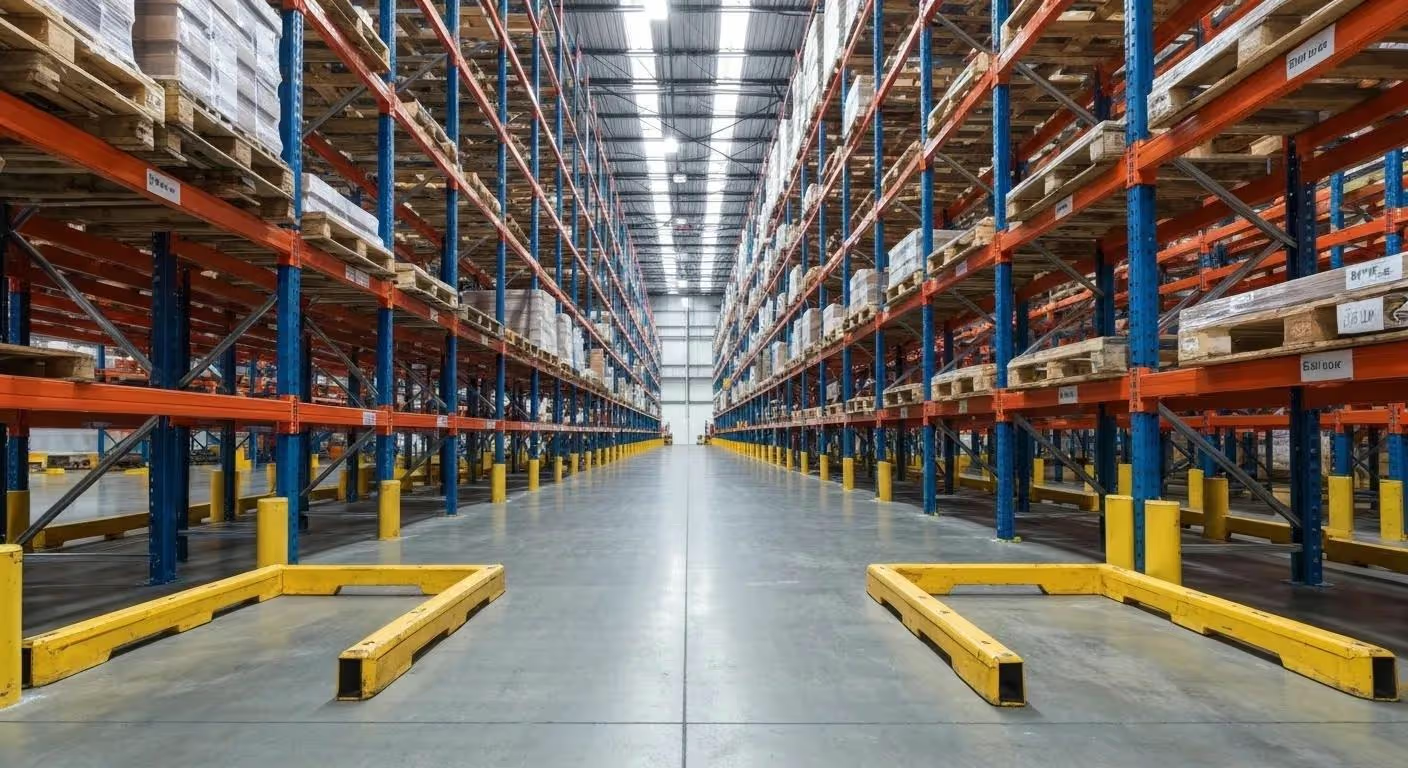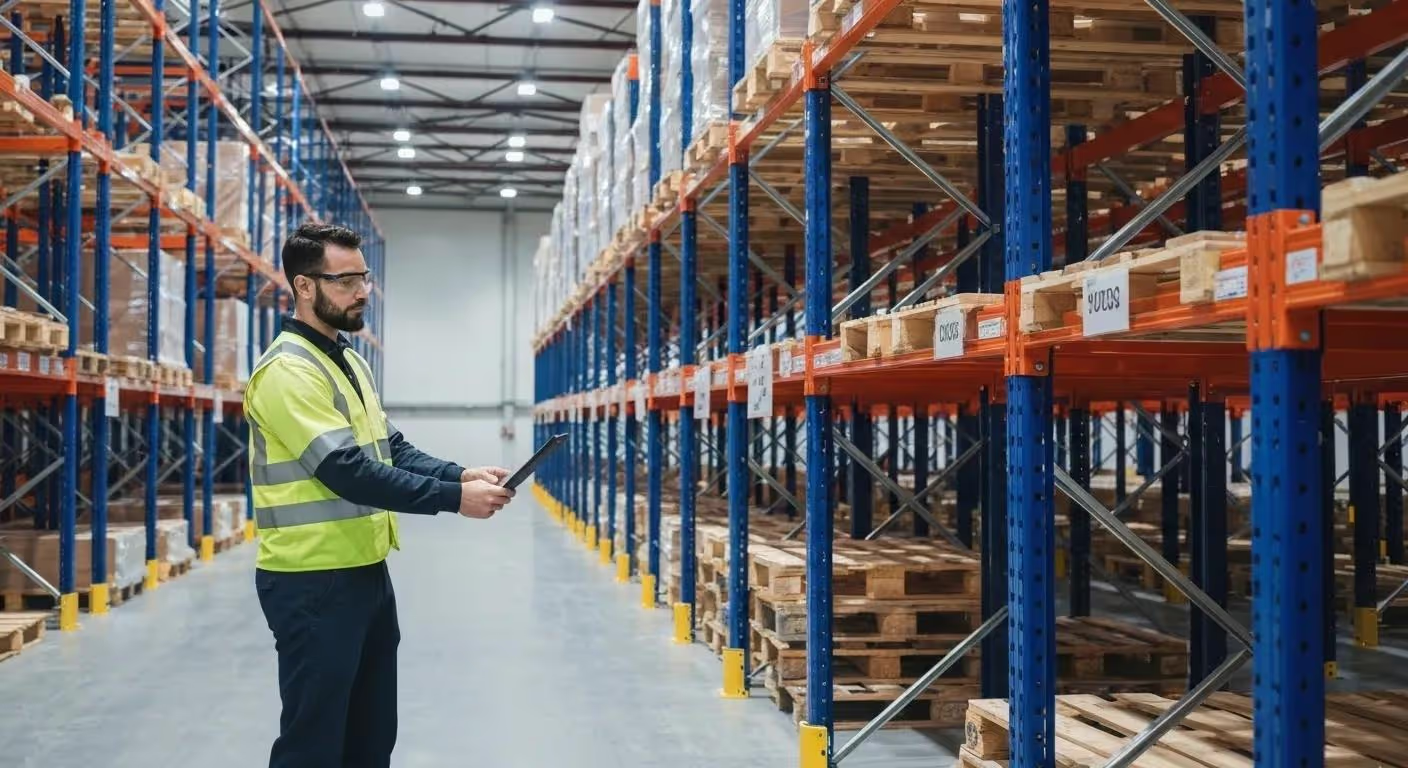
Efficient warehouse storage hinges on selecting the right pallet racking size and ensuring adequate clearance between racks for both safety and productivity. At Skyteck Online, we recognise that precise pallet racking dimensions from upright depths to beam lengths and the required horizontal, vertical, aisle, and flue space clearances directly influence material flow, forklift maneuverability, and fire protection. This guide covers six core themes:
- Standard component dimensions for uprights, beams, and pallets
- Essential clearance requirements for operational safety
- How different racking types affect sizing and spacing
- The latest 2025 regulatory compliance for racking systems
- Practical methods to calculate and optimise rack size and clearance
- Real-world case studies and ongoing maintenance best practices
By following these structured insights, warehouse managers and safety officers can configure pallet racking systems that maximise storage density, uphold industry standards, and streamline daily operations without compromising safety.
What Are the Standard Pallet Racking Dimensions for Uprights, Beams, and Pallets?
Pallet racking dimensions define how goods are stored, accessed, and handled safely in a warehouse. Establishing standard upright frame depths and heights, beam lengths and load capacities, and pallet footprint specifications ensures compatibility and uniform load distribution. For example, matching a 48-inch deep pallet with a 42-inch upright frame optimises support and minimises overhang risk.
What Are Common Upright Frame Depths and Heights for Pallet Racking?
Upright frames serve as the vertical support structure for beams and pallets. Typical upright frame depths range from 36″ to 48″ to suit standard pallet depths and allow for beam mounting. Heights commonly extend from 8 feet up to 24 feet, increasing in 2-foot increments to align with warehouse ceiling heights and forklift reach.

Selecting the correct depth and height prevents beam misalignment and ensures that pallet loads remain centered, laying the groundwork for proper beam sizing and load capacity planning.
What Are Standard Beam Lengths and Their Load Capacities?
Beams bridge between upright frames and bear pallet weight. Standard beam lengths include 8′, 9′, 10′, and 12′, accommodating one to three standard pallets side by side. Beam face heights vary from 3″ to 6″, with taller profiles delivering higher load capacities.

Choosing the right beam length and face height directly influences load distribution and rack safety, leading into how pallet dimensions and overhang impact rack configuration.
What Are the Typical Pallet Sizes and Recommended Overhangs?
Standard pallet footprints include 40″×48″ (GMA), 48″×48″, and European sizes like 1200 × 800 mm. Maintaining a pallet overhang of approximately 3″ on each side ensures secure placement on beams and even weight distribution.
- 40″×48″ GMA pallet for North American distribution
- 48″×48″ pallet common in heavy-duty and export operations
- 1200 × 800 mm European pallet for intermodal logistics
Consistent pallet sizing and controlled overhang reduce shifting during forklift handling and support accurate clearance planning between racks.
How Does Wire Decking Affect Pallet Racking Dimensions?
Wire decking sits atop beams to support pallets, distributing point loads and improving visibility. Standard decking panels measure the beam span and typically add 1″ of thickness. When installed, decking raises pallet height slightly, requiring an adjustment in vertical clearance calculations to maintain safe beam-to-load and ceiling spacings.
By understanding how decking influences overall rack height, planners can refine clearance requirements and fire suppression access before evaluating specific clearance zones.
What Are the Essential Clearance Requirements Between Pallet Racks for Safety and Efficiency?

Proper clearances prevent collisions, ensure safe lifting, and maintain regulatory compliance. Horizontal, vertical, aisle, and flue space clearances each serve unique safety functions, from forklift maneuvering to sprinkler system access.
What Is the Minimum Horizontal Clearance Between Pallets and Between Pallets and Upright Frames?
Horizontal clearance refers to lateral gaps that prevent load contact with rack structures or adjacent pallets.
- A minimum of 6″ clearance between side-by-side pallets avoids load abrasion.
- At least 3″ clearance between pallet edges and upright frames prevents pallet jamming and frame damage.
Maintaining these horizontal spacings reduces rack collisions and ensures seamless pallet insertion and removal, setting the stage for vertical clearance requirements.
What Are the Recommended Vertical Clearances Between Loads, Beams, and Ceiling?
- Lower beam levels: 4″ clearance between pallet top and beam below.
- Higher beam levels: 6″ clearance to accommodate fork tilt and stabilise loads.
- Ceiling and sprinkler systems: 18″–24″ clearance above the top beam ensures unobstructed fire suppression coverage.
These vertical gaps enable safe stacking practices and maintain effective sprinkler operation in line-with fire safety regulations.
How Wide Should Warehouse Aisles Be for Forklift Maneuvering?
Aisle width must match the forklift’s turning radius plus buffer space for safe operation. As a rule of thumb:
For example, a counterbalanced forklift with a 60″ turning radius requires an aisle of approximately 72″ to 78″. Proper aisle sizing minimises collision risks and improves material-handling throughput.
What Is Flue Space and Why Is It Important for Fire Safety?
Flue space comprises vertical and horizontal channels that allow sprinkler water flow between rack rows. Transverse flue space of at least 6″ and longitudinal flue space of 3″ are required under NFPA 13. These gaps ensure that sprinkler spray can penetrate all storage levels, reducing fire spread and supporting code compliance.
Understanding flue space requirements completes the overall clearance strategy and leads into how different racking types influence these parameters.
How Do Different Types of Pallet Racking Affect Size and Clearance Requirements?
Each racking system like selective, drive-in, push-back, pallet flow, and cantilever carries unique dimension and spacing implications. Matching rack type to inventory flow and density needs optimises space utilisation and safety.
What Are the Standard Dimensions and Clearances for Selective Pallet Racking?
Selective racking offers direct pallet access and uses standard uprights and beams. Typical clearances mirror the values outlined above: 36″–48″ frame depths, 8′–24′ heights, 6″ pallet-to-pallet spacing, and 3″ pallet-to-frame gaps. Aisle widths follow forklift radius calculations, and flue spaces of 6″ transverse and 3″ longitudinal remain standard. This versatility makes selective racking suitable for diverse SKU profiles.
How Do Drive-In and Drive-Thru Racking Systems Differ in Size and Clearance?
Drive-in and drive-thru racking maximise storage density by eliminating multiple aisles.
- Frame depths from 96″ to 144″ to accommodate multiple pallets in depth
- Beam levels spaced 12″–15″ apart for pallet accommodation
- Clearance to guide rails: 2″–4″ on each side to allow entry without contact
While space-saving, these systems demand precise horizontal alignment and regular maintenance to prevent forklift-to-rack collisions.
What Are the Size Considerations for Push-Back and Pallet Flow Racking?
High-density push-back uses sliding carts on inclined rails, typically requiring frame depths from 72″ to 120″. Pallet flow uses gravity rollers, with depths tailored to the number of pallets per lane. Both systems need:
- Depth allowances matching lane length
- 4″–6″ vertical separation between pallets to permit roller clearance
- End-of-lane bumpers and sway braces to control pallet movement
These investments increase throughput density but require detailed clearance mapping for incline and roller systems.
How Is Cantilever Racking Sized for Non-Palletised Loads?
Cantilever racking supports long items such as pipes, lumber and tubing on horizontal arms rather than beams. Depth depends on load length, often 48″ to 96″. Arm lengths extend from 24″ to 72″, spaced 12″–18″ vertically to support distributed loads. Horizontal clearance between arms should be 4″ to allow handling equipment access, and aisle widths follow specialised equipment dimensions. Cantilever sizing focuses on load profile rather than standard pallet metrics.
What Are the Latest Pallet Racking Safety Standards and Regulatory Compliance Requirements for 2025?

Adhering to current OSHA, ANSI/RMI, NFPA, and AS4084 standards safeguards workers and equipment. The 2025 landscape emphasises updated design specifications, fire safety, and inspection protocols.
What OSHA Guidelines Apply to Pallet Racking Safety and Clearance?
OSHA’s General Duty Clause requires employers to provide hazard-free workspaces, including rack systems. Recommended practices include maintaining specified clearances are 3″ pallet-to-column and 6″ between loads, and posting load capacities at each bay. Regular safety training on proper rack use also falls under OSHA oversight.
How Do ANSI/RMI 16.1-2023 Standards Influence Pallet Racking Design?
ANSI/RMI MH16.1-2023 establishes rigorous design, testing, and utilisation criteria for industrial steel storage racks. It specifies structural calculations for uprights and beams, minimum connector yield strengths, and mandatory base-plate anchoring. These dimensions and tolerances directly inform frame depth, height, and beam profiling to meet compliance thresholds.
What NFPA Fire Safety Regulations Affect Pallet Racking Clearances?
NFPA 13 mandates flue spaces of at least 6″ (transverse) and 3″ (longitudinal) between rows, plus 18″–24″ overhead clearance to sprinklers. It also requires unobstructed aisle access and automatic sprinkler documentation. Rack layouts must facilitate quick water penetration across storage levels in accordance with sprinkler design criteria.
What Are the Key Updates in Australian Standard AS4084-2023 for Pallet Racking?
AS4084-2023 introduces mandatory annual audits, seismic load considerations, and corner-post protection requirements. Upright anchoring torque specifications and beam-to-column connector inspections now occur annually, ensuring rack integrity in moderate to high seismic zones. These mandates reinforce global consistency in rack safety and maintenance.
Why Are Load Capacity Signage and Regular Inspections Important?
Posting clear load capacity signage at each rack bay informs operators of maximum allowable weights, preventing overloading.
Structured inspection programs such as quarterly visual checks and annual structural audits, identify deformations, loose connectors, and beam misalignments before they become safety hazards.
How Can You Calculate and Optimise Pallet Racking Size and Clearance for Your Warehouse?
Practical measurement and optimisation improve throughput and space utilisation. By accounting for component dimensions, pallet profiles, forklift characteristics, and clearance requirements, planners can configure efficient layouts.
What Factors Should Be Considered When Measuring Pallet Racking Components?
Accurate rack measurement covers upright depth and height, beam length and face height, and decking thickness. Use calibrated gauges to record:
- Upright column depth and bay width
- Beam span between uprights and face profile
- Wire decking thickness addition to load height
Consistent measurement ensures rack stability and aligns with clearance planning, leading to correct pallet overhang assessments.
How Do Pallet Dimensions and Overhang Influence Rack Sizing?
Pallet footprints and overhang directly determine beam length selection. A 48″ deep pallet with 3″ overhang on each side requires a beam span of at least 54″ to maintain full support. Overhang allowances also impact horizontal clearance between rows, ensuring forklift access without contact.
Calculating these factors together yields optimal beam and frame combinations that meet handling requirements.
How to Determine Aisle Width Based on Forklift Turning Radius?
Aisle width equals twice the forklift’s load center distance plus turning clearance. For a forklift with a 60″ load center and 72″ turning radius:
This formula balances maneuverability with storage density and can be adjusted for specialised equipment dimensions.
Are There Tools or Calculators to Help Optimise Rack Dimensions?
Several software tools and online calculators allow users to input pallet length, width, rack height, and forklift radius to output recommended beam spans, frame depths, and aisle widths. These calculators automate complex spatial analysis, enabling rapid scenario comparisons and layout simulations.
What Are Real-World Examples and Case Studies Demonstrating Optimal Pallet Racking Sizes and Clearances?
Applying theory to practice illustrates the impact of precise rack design on efficiency and safety. Successful implementations often share measurable performance gains and accident reductions.
How Did a Major Logistics Provider Improve Efficiency with Optimised Aisle Clearances?
A leading beverage distributor reconfigured aisle widths based on forklift turning radius analysis, expanding aisles from 72″ to 84″. This adjustment reduced rack collisions by 35% and improved pallet throughput by 18% during peak operations, demonstrating how marginal clearance changes yield significant operational benefits.
What Are Common Warehouse Layouts and Their Impact on Rack Dimensions?
Common layouts include single-aisle, double-aisle, and cross-aisle patterns. Single-aisle designs prioritise maximum rack length but require precise aisle spacing, while double-aisle systems increase accessibility at the cost of reduced rack runs. Cross-aisle layouts balance accessibility and density by introducing perpendicular aisles every few bays.
How Does Warehouse Automation Influence Pallet Racking Size and Clearance?
Automated storage and retrieval systems (AS/RS) demand highly precise rack geometry. Rack tolerances tighten to within ±¼″, aisle clearances narrow to the automated vehicle width, and flue spaces must remain unobstructed for robotic sprayers. These stricter requirements drive more rigorous dimension control and clearance audits.
What Are Best Practices for Maintaining Pallet Racking Safety and Compliance Over Time?
Ongoing management ensures rack integrity, operational safety, and regulatory adherence. Scheduled inspections, training, and signage upkeep reinforce a safety-first culture.
How Often Should Pallet Racking Be Inspected and Audited?
Visual inspections are recommended quarterly to identify bent beams, loose bolts, or impact damage. Comprehensive structural audits should occur annually, verifying upright straightness, connector torque, and beam locks.
What Are Common Safety Issues Related to Incorrect Rack Sizing and Clearance?
- Impact damage from forklifts in narrow aisles
- Overloading due to unclear capacity signage
- Inadequate flue space leading to sprinkler obstruction
Addressing these risks through precise sizing and spacing prevents accidents and equipment failures.
How to Implement Load Capacity Signage and Employee Training?
Post clear, durable capacity signs at each bay showing maximum loads. Conduct hands-on training sessions twice yearly, covering correct forklift operation, rack inspection protocols, and emergency procedures. Empowered employees contribute to a safer warehouse environment over the long term.
Pallet racking size and clearance are fundamental to warehouse safety, efficiency, and compliance. By standardising component dimensions, maintaining precise horizontal, vertical, aisle, and flue clearances, and adhering to 2025 regulatory standards, operators can create robust storage systems. Practical measurement techniques, layout optimisation tools, and real-world case studies demonstrate tangible gains in throughput and accident reduction. Regular inspections, clear signage, and targeted training ensure ongoing rack integrity and a culture of safety that supports sustainable warehouse operations.


.svg)






